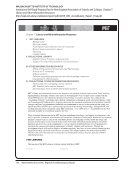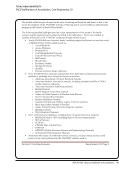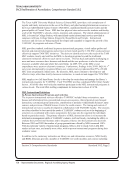108 · Representative Documents: Regional Accrediting Agency Reports
Brigham Young University
Northwest Commission on Colleges and Universities (NWCCU). Library and Information Resources 5
materials and the other to rare books and manuscripts. Broader responsibility for conserving
library collections is assigned to a preservation team that formulates policies
and procedures for emergency preparedness, disaster response, environmental controls, security,
and care and handling of materials.
Facilities for Students
The libraries offer pleasant study environments in well-lit, open-seating areas with
cherrywood furniture. The Lee Library offers seating for over 4,000 and the Hunter Library for
nearly 1,000 additional users. With this combined seating capacity, approximately 16 percent of
BYU’s student body can be accommodated in the libraries.
Library facilities are designed to accommodate evolving study habits of twenty-first-
century students who desire ready access to technology and often prefer to study in collaborative
group settings.
The libraries have embraced technology as a powerful means of delivering scholarly
information to the campus community by providing sufficient access tools and strong network
connectivity crucial to library service. The Lee Library’s 1999 building addition includes a floor
grid that provides power and network connections every five feet in any direction. This grid
currently supports 324 computer workstations near reference desks, 60 in Information Commons
areas, 276 in library open access labs, and 100 in four technology- enhanced library instruction
rooms. A total of 57 group study rooms have an average occupancy rate of 60 percent over the
course of a semester, with nearly 100 percent use during peak periods of the semester.
Older areas in the building were remodeled to provide essentially the same level of
connectivity as in new spaces. Wired furniture was installed throughout the Lee and Hunter
buildings to facilitate student and faculty use of computers for accessing digital content. By
2004, both the Lee and Hunter Libraries offered wireless connectivity that reached into most
major study areas within their facilities, and laptops are frequently in use in all study areas of the
libraries.
In the Lee Library, four technology-enhanced classrooms equipped for hands-on
instruction are heavily scheduled. Three similar rooms are available in the Hunter Library. A
large technologyenhanced classroom adjacent to the Special Collections exhibition gallery
provides a secure venue where rare books and manuscripts can be incorporated into lectures and
presentations to students and library guests. In the Learning Resource Center there are four
viewing rooms for classes using audio-visual resources. The Lee Library’s 213-seat, technology-
enhanced auditorium is a popular venue for both library-sponsored and university-sponsored
lectures, symposia, film screenings, and large class instruction. Many of the outreach events held
in the auditorium are captured on video for later broadcast on KBYU and BYUTV. Classroom
and auditorium facilities in the libraries are popular resources for the entire university as well as
for guests from the surrounding community.
Library facilities are fully accessible to students with disabilities. Aisle width and
accessible furniture ensure ease of use for individuals with mobility impairments. An eight-
workstation lab equipped with the latest assistive technology supports students with sight,
hearing, or mobility impairments. On average, 60 students use the facility for a total of 1,700
hours each semester. Another lab provides quiet study space for students with learning
disabilities. Both facilities are proctored in collaboration with the University Accessibility
Center.
Brigham Young University
Northwest Commission on Colleges and Universities (NWCCU). Library and Information Resources 5
materials and the other to rare books and manuscripts. Broader responsibility for conserving
library collections is assigned to a preservation team that formulates policies
and procedures for emergency preparedness, disaster response, environmental controls, security,
and care and handling of materials.
Facilities for Students
The libraries offer pleasant study environments in well-lit, open-seating areas with
cherrywood furniture. The Lee Library offers seating for over 4,000 and the Hunter Library for
nearly 1,000 additional users. With this combined seating capacity, approximately 16 percent of
BYU’s student body can be accommodated in the libraries.
Library facilities are designed to accommodate evolving study habits of twenty-first-
century students who desire ready access to technology and often prefer to study in collaborative
group settings.
The libraries have embraced technology as a powerful means of delivering scholarly
information to the campus community by providing sufficient access tools and strong network
connectivity crucial to library service. The Lee Library’s 1999 building addition includes a floor
grid that provides power and network connections every five feet in any direction. This grid
currently supports 324 computer workstations near reference desks, 60 in Information Commons
areas, 276 in library open access labs, and 100 in four technology- enhanced library instruction
rooms. A total of 57 group study rooms have an average occupancy rate of 60 percent over the
course of a semester, with nearly 100 percent use during peak periods of the semester.
Older areas in the building were remodeled to provide essentially the same level of
connectivity as in new spaces. Wired furniture was installed throughout the Lee and Hunter
buildings to facilitate student and faculty use of computers for accessing digital content. By
2004, both the Lee and Hunter Libraries offered wireless connectivity that reached into most
major study areas within their facilities, and laptops are frequently in use in all study areas of the
libraries.
In the Lee Library, four technology-enhanced classrooms equipped for hands-on
instruction are heavily scheduled. Three similar rooms are available in the Hunter Library. A
large technologyenhanced classroom adjacent to the Special Collections exhibition gallery
provides a secure venue where rare books and manuscripts can be incorporated into lectures and
presentations to students and library guests. In the Learning Resource Center there are four
viewing rooms for classes using audio-visual resources. The Lee Library’s 213-seat, technology-
enhanced auditorium is a popular venue for both library-sponsored and university-sponsored
lectures, symposia, film screenings, and large class instruction. Many of the outreach events held
in the auditorium are captured on video for later broadcast on KBYU and BYUTV. Classroom
and auditorium facilities in the libraries are popular resources for the entire university as well as
for guests from the surrounding community.
Library facilities are fully accessible to students with disabilities. Aisle width and
accessible furniture ensure ease of use for individuals with mobility impairments. An eight-
workstation lab equipped with the latest assistive technology supports students with sight,
hearing, or mobility impairments. On average, 60 students use the facility for a total of 1,700
hours each semester. Another lab provides quiet study space for students with learning
disabilities. Both facilities are proctored in collaboration with the University Accessibility
Center.
























































































































































































